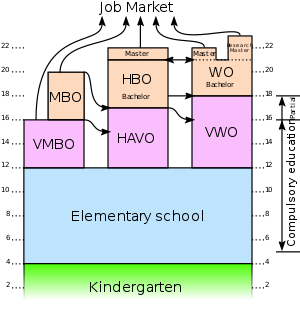Education in the Netherlands
From Wikipedia, the free encyclopedia
 | |
| Ministry of Education, Culture and Science | |
|---|---|
| Minister of Education | Jet Bussemaker |
| National education budget (2014) | |
| Budget | €32,1 billion ($42 billion) |
| General details | |
| Primary languages | Dutch Bilingual/Trilingual (with English, German, French or West Frisian (only in the northern part of the Netherlands) |
| Current system | 1968 (Mammoetwet). 1999 (latest revision). |
| Enrollment (200) | |
| Total | over 1200 students |
| Primary | 400 |
| Secondary | 300 |
| Post secondary | 300 |
Education in the Netherlands is characterized by division: education is oriented toward the needs and background of the pupil. Education is divided over schools for different age groups, some of which are divided in streams for different educational levels. Schools are furthermore divided in public, special (religious), and general-special (neutral) schools,[1] although there are also a few private schools. The Dutch grading scale runs from 1 (very poor) to 10 (outstanding).
The Programme for International Student Assessment (PISA), coordinated by the Organization for Economic Co-operation and Development (OECD), ranks the education in the Netherlands as the 9th best in the world as of 2008, being significantly higher than the OECD average.[2]


